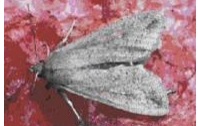We’ve received reports of an abundance of moths in and around homes. Two species
commonly found this time of year are the green cloverworm and army cutworm moths.
Green cloverworm moths are small and gray-black/brown with dark, mottled markings on the wings. The wingspan is about one-inch and when folded, the wings make a triangular shape. At rest, you may notice snout-like mouthparts protruding from the head. Green cloverworm larvae are typically not able to overwinter in Kansas, so the fact that the moths are present now does not indicate an infestation is likely next year.
Army cutworm moths, sometimes referenced as miller moths, vary in color and
patterning. Females are mostly gray; males are primarily brown. When disturbed, the wings drop scales leaving behind a dusty substance. Miller moths migrate to Kansas
this time of year to lay eggs which hatch in fall and early winter. On warmer winter days, larvae will feed on available hosts, burrowing back into the soil as temperatures drop. However, K-State Entomology specialists do not see this to be a major problem homeowners should be concerned with due to the short season and minimal damage.
The larvae of these moths are common crop pests. Moths are a pest primarily due to
their attraction to lights at nighttime. They are able to fit into tiny crevices making it
difficult to exclude them. Rest assured, as the temperature drops, the number of moths
will decrease as well.



